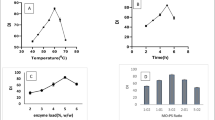Abstract
Conjugated linoleic acid-rich soy oil (CLARSO) has been shown to have numerous health benefits, including anti-obesity and anti-carcinogenic properties. This oil was previously used to produce CLA-rich margarine that showed physical characteristics similar to commercially available margarine. The objective of this study was to produce CLA-rich shortening and analyze its physical properties relative to commercially available shortenings and soy oil control shortenings. The shortenings were prepared and their rheology, thermal behavior, and solid fat content (SFC) were determined and compared to the commercial samples. The CLA-rich shortening samples showed similar rheological properties to the commercial samples and showed a better consistency (more solid-like behavior) compared to the soy oil control samples. In addition, the CLA-rich shortenings also have a higher SFC (% SFC) as well as higher latent heat of crystallization and melting than the soy oil controls indicating a comparatively higher crystalline fraction. Thus, CLARSO produced firmer shortenings than did conventional soy oil by interacting with the crystallizing stearin fraction and consequently increasing the crystalline mass fraction without significantly altering the microstructure kinetics of solid fat crystallization.








Similar content being viewed by others
References
Whigham LD, Cook ME, Atkinson RL (2000) Conjugated linoleic acid: implications for human health. Pharmacol Res 42(6):503–510
Cesano A, Visonneau S, Scimeca JA, Kritchevsky D, Santoli D (1998) Opposite effects of linoleic acid and conjugated linoleic acid on human prostatic cancer in SCID mice. Anticancer Res 18:1429–1434
Kim EJ, Holthuizen PE, Park HS, Ha YL, Jung KC, Park Y (2002) Trans-10, cis-12-conjugated linoleic acid inhibits Caco-2 colon cancer cell growth. Am J Physiol Gastrointest Liver Physiol 283:G357–G367
Feitoza AB, Pereira AF, Ferreira da Costa N, Ribeiro BG (2009) Conjugated linoleic acid (CLA): effect modulation of body composition and lipid profile. Nutr Hosp 24:422–428
Nicolosi RJ, Rogers EJ, Kritchevsky D, Scimeca JA, Huth PJ (1997) Dietary conjugated linoleic acid reduces plasma lipoproteins and early aortic atherosclerosis in hypercholesterolemic hamsters. Artery 22:266–277
McGuire MA, McGuire MK (1999) Conjugated linoleic acid (CLA): a ruminant fatty acid with beneficial effects on human health. Proc Am Soc Anim Sci 77:1–8
Gilbert W, Gadang V, Proctor A, Jain V, Katwa L, Gould A, Devareddy L (2011) trans, trans-Conjugated linoleic acid rich soy bean oil increases PPAR-gene expression and alleviates insulin resistance and cardiovascular risk factors. Lipids 46:961–968
Ip C, Chin SF, Scimeca JA, Pariza MW (1991) Mammary cancer prevention by conjugated dienoic derivative of linoleic acid. Cancer Res 51:6118–6124
Mougios V, Matsakas A, Petridou A, Ring S, Sagredos A, Melissopoulou A, Tsigilis N, Nikolaidis M (2001) Effect of supplementation with conjugated linoleic acid on human serum lipids and body fat. J Nutr Biochem 12:585–594
Gangidi RR, Proctor A (2004) Photochemical production of conjugated linoleic acid from soybean oil. Lipids 39:577–582
Shah U, Proctor A (2013) Conjugated linoleic acid (CLA)-rich vegetable oil production from linoleic rich oils by heterogeneous catalysis. U.S. Patent Application Serial No. 13/692,619
Yettella RR, Castrodale C, Proctor A (2012) Effect of added conjugated linoleic acid and iodine concentration on conjugated linoleic acid rich soy oil oxidative stability. J Am Oil Chem Soc 89:1939–1941
Ruan C, Proctor A (2014) Physicochemical properties of conjugated linoleic acid-rich soy oil. J Am Oil Chem Soc 91:49–54
Shah U, Patel AR, Van de Walle D, Rajarethinem PS, Proctor A, Dewettinck K (2014) CLA-rich soy oil margarine production and characterization. J Am Oil Chem Soc 91:309–316
Tang D, Marangoni AG (2006) Microstructure and fractal analysis of fat crystal networks. J Am Oil Chem Soc 83:377–388
Hernandez M, Eldin AK (2013) Processing and nutrition of fats and oils. Wiley, New York
Lall RK, Proctor A, Jain VP (2009) A rapid, micro FAME preparation method for vegetable oil fatty acid analysis by gas chromatography. J Am Oil Chem Soc 86(4):309–314
Braipson-Danthine S, Deroanne C (2004) Influence of SFC, microstructure and polymorphism on texture (hardness) of binary blends of fats involved in the preparation of industrial shortenings. Food Res Int 37:941–948
Himawan C, Starov VM, Stapley AGF (2006) Thermodynamic and kinetic aspects of fat crystallization. Adv Colloidal Interface Sci 122:3–33
Acknowledgments
The authors would like to acknowledge the Arkansas Soybean Promotion Board, Arkansas BioScience Institute, University of Arkansas Honors College, the Arkansas Student Undergraduate Research Fund and the University of Gent International Programs for their financial support of this research. We also thank Riceland Food and ADM for providing RBD soy oil and stearin, respectively.
Author information
Authors and Affiliations
Corresponding author
About this article
Cite this article
Mayfield, S., Proctor, A., Shinn, S.E. et al. CLA-Rich Soy Oil Shortening Production and Characterization. J Am Oil Chem Soc 92, 1267–1275 (2015). https://doi.org/10.1007/s11746-015-2705-5
Received:
Revised:
Accepted:
Published:
Issue Date:
DOI: https://doi.org/10.1007/s11746-015-2705-5




